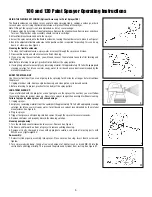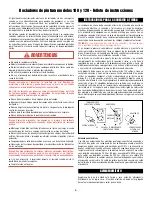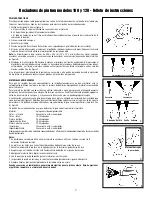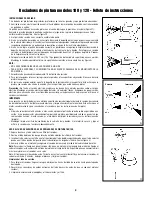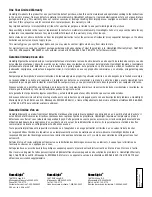
3
PRACTICE FIRST
Practice spraying water on newspaper or cardboard. This will give you the feel of the sprayer and all
its features. Follow the instructions for adjusting to the proper spray pattern.
1. Check the following: See Figure A.
a. Atomizer valve assembly is in cartridge.
b. Spray nozzle is screwed on tightly
c. Pick-up tube with filter is inserted tightly into tall cylinder port of pump housing.
2. Fill container with water.
3. Plug in sprayer
4. Press trigger. Allow a few seconds for the pump to spray material.
5. As you spray, notice the difference in spray volume and spray pattern while adjusting the control
knob. Adjust the control knob until you get the best possible spray pattern.
NOTE: The best distance for spraying is 10" -12". Too far away may cause excessive over spraying and
too close may cause excessive paint build-up. See Figure B.
6. Keep a stiff wrist. Do not arch your wrist at the beginning or the end of the stroke. Do not stop the
motion of the unit while spraying. The path of the sprayer must pass beyond the area being painted
and the flow of paint must be triggered on and off as the sprayer passes into and out of the spraying
area. See Figure C.
Stopping the motion of the sprayer or swinging into a new stroke pattern while paint is being delivered
will result in heavy paint build-up at the edges of the stroke.
THINNING MATERIALS
In order for your sprayer to operate properly it is important to make sure the material is thin enough
to be sprayed. Paint should be thinned by adding the appropriate material recommended by the paint
manufacturer.
For latex paints, use a lubricant additive, or water, to prevent excess piston wear and possible seizure
of the piston. Floetrol (brand name) is a lubricant additive that should be added before thinning paint
with water, then if further thinning is needed add water.
Following is a general thinning guide using the viscosity cup provided (Figure D). Because materials
differ from brand to brand, this guide can only be a place to start. The final guide to correctly thinned
paint is achieving the proper spray pattern. See Figure E.
The final guide to correctly thinned paint is achieving the proper spray pattern.
Material
General Thinning Guide
Stains - Oil
Use as is, unthinned
Stains - Latex
10-25 seconds
Latex Paint
35-45 seconds
Latex Primer
35-45 seconds
Oil Base Paint
15-25 seconds
Insecticides
Use as is, unthinned
Water Sealer
Use as is, unthinned
Always follow the coverage rate recommended by the manufacturer regardless of the thinning required.
Notes:
1. Additional thinning may be required when using the suction tube and/or the flexible spray extension.
2. Old paint or stain should be strained before using.
3. Stir paint slowly, do not shake to prevent air bubbles.
4. Be sure suction tube is tightly inserted in correct intake port.
5. Thin material to proper viscosity.
6. Use the correct spray tip for the material being used.
7. Check spray tip and atomizer valve for wear.
8. Always clean and oil sprayer thoroughly after each use.
When a low humming sound is heard, usually the piston has seized, immediately stop pressing
on the trigger, or damage to the motor can occur.
100 and 120 Paint Sprayer Operating Instructions
Thin materials
as needed
A
D
B
Start Trigger Release End
C
E
Correct
Incorrect





